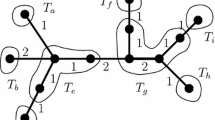Abstract
Generalizing the concept of tree metric, Hirai (2006) introduced the concept of subtree distance. A mapping \(d:X\times X \rightarrow \mathbb {R}_+\) is called a subtree distance if there exist a weighted tree T and a family \(\{T_x\,|\,x \in X\}\) of subtrees of T indexed by the elements in X such that \(d(x,y)=d_T(T_x,T_y)\), where \(d_T(T_x,T_y)\) is the distance between \(T_x\) and \(T_y\) in T. Hirai (2006) gave a characterization of subtree distances which corresponds to Buneman’s four-point condition (1974) for the tree metrics. Using this characterization, we can decide whether or not a given matrix is a subtree distance in O\((n^4)\) time. However, the existence of a polynomial time algorithm for finding a tree and subtrees representing a subtree distance has been an open question. In this paper, we show an O\((n^3)\) time algorithm that finds a tree and subtrees representing a given subtree distance.
K. Ando—This work was supported by JSPS KAKENHI Grant Number 15K00033.
Access this chapter
Tax calculation will be finalised at checkout
Purchases are for personal use only
Similar content being viewed by others
References
Ando, K.: Computation of the Shapley value of minimum cost spanning tree games: #P-hardness and polynomial cases. Jpn. J. Ind. Appl. Math. 29, 385–400 (2012)
Buneman, P.: A note on metric properties of trees. J. Comb. Theory Ser. B 17, 48–50 (1974)
Culberson, J.C., Rudnicki, P.: A fast algorithm for constructing trees from distance matrices. Inf. Process. Lett. 30, 215–220 (1989)
Hirai, H.: Characterization of the distance between subtrees of a tree by the associated tight span. Ann. Comb. 10, 111–128 (2006)
Hirai, H.: Half-integrality of node-capacitated multiflows and tree-shaped facility locations on trees. Math. Program. Ser. A 137, 503–530 (2013)
Saitou, N., Nei, M.: The neighbor-joining method: a new method for reconstructing phylogenetic trees. Mol. Biol. Evol. 4, 405–425 (1987)
Acknowledgments
The authors are grateful to Professor Hiroshi Hirai for useful suggestions for the design of the algorithm presented in this paper. Thanks are also due to the anonymous referees for their useful comments which improved the presentation of our results.
Author information
Authors and Affiliations
Corresponding author
Editor information
Editors and Affiliations
Rights and permissions
Copyright information
© 2016 Springer International Publishing Switzerland
About this paper
Cite this paper
Ando, K., Sato, K. (2016). An Algorithm for Finding a Representation of a Subtree Distance. In: Cerulli, R., Fujishige, S., Mahjoub, A. (eds) Combinatorial Optimization. ISCO 2016. Lecture Notes in Computer Science(), vol 9849. Springer, Cham. https://doi.org/10.1007/978-3-319-45587-7_22
Download citation
DOI: https://doi.org/10.1007/978-3-319-45587-7_22
Published:
Publisher Name: Springer, Cham
Print ISBN: 978-3-319-45586-0
Online ISBN: 978-3-319-45587-7
eBook Packages: Computer ScienceComputer Science (R0)




